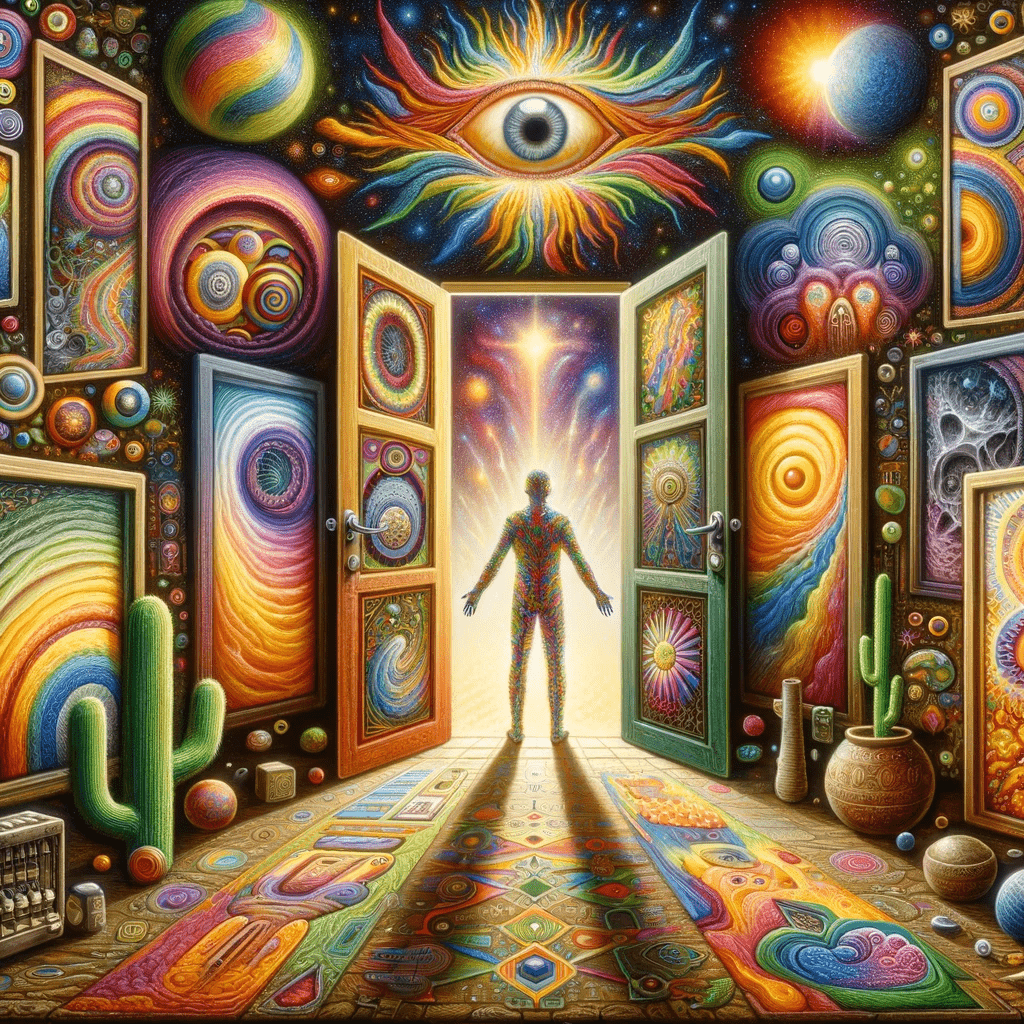The Doors of Perception

“The Doors of Perception” is a groundbreaking work by Aldous Huxley, first published in 1954, in which he details his experiences with mescaline, a psychoactive substance derived from the peyote cactus. Huxley’s exploration into the realm of psychedelics and altered states of consciousness offers a unique perspective on the human mind and its potential for self-discovery.
- The doors of perception as a metaphor: Huxley uses the title as a metaphor for the mind’s ability to filter and process the vast amount of information it receives from the world. He argues that these “doors” can be opened through the use of psychedelic substances, allowing us to access previously hidden aspects of reality and our own consciousness.
- The mescaline experience: Huxley describes in detail his experience of taking mescaline, which he considers a powerful tool for self-exploration and spiritual insight. He recounts the sensations, thoughts, and emotions he experienced during the trip, including a heightened awareness of color, texture, and form, as well as a profound sense of oneness with the universe.
- Art and the visionary experience: Huxley discusses the relationship between psychedelic experiences and the creative process. He posits that artists throughout history have tapped into a similar visionary state, which allows them to perceive and communicate profound truths about the human condition. He cites examples from various art forms, including painting, literature, and music.
- The limitations of language: Huxley emphasizes the difficulty of articulating the psychedelic experience in words, as it transcends ordinary language and rational thought. He explores the inadequacy of language as a medium for conveying the full depth and complexity of the mescaline experience.
- The potential for personal transformation: Huxley argues that psychedelic substances can facilitate significant personal growth and transformation by allowing us to confront and transcend our fears, anxieties, and limiting beliefs. He believes that these experiences can lead to a greater understanding of the self and our place in the universe.
- The mystical experience: Huxley draws parallels between the mescaline experience and mystical states described in various religious and spiritual traditions. He suggests that these substances can provide a means of accessing the divine or transcendent aspects of reality, which are typically inaccessible through ordinary consciousness.
- The potential dangers and misuse of psychedelics: While Huxley is largely positive about the potential benefits of psychedelic substances, he acknowledges the potential for abuse and harm. He cautions against the indiscriminate use of these substances, emphasizing the importance of proper guidance, intention, and context for a safe and meaningful experience.
Important people mentioned in the book:
- William Blake: English poet and painter whose work is referenced by Huxley as an example of visionary art inspired by altered states of consciousness.
- Dr. Humphry Osmond: A British psychiatrist who provided Huxley with the mescaline for his experiment and supervised the experience.
- C.D. Broad: British philosopher whose concept of the “mind at large” is discussed by Huxley as a way to understand the broader implications of the psychedelic experience.
Books written about “The Doors of Perception”:
- “Moksha: Aldous Huxley’s Classic Writings on Psychedelics and the Visionary Experience” by Aldous Huxley, edited by Michael Horowitz and Cynthia Palmer: This anthology collects Huxley’s writings on psychedelics and the visionary experience, including essays and letters discussing “The Doors of Perception.”
- “Aldous Huxley and the Search for Meaning: A Study of the Eleven Novels” by Ronald T. Sion: This book examines Huxley’s novels and non-fiction works, including “The Doors of Perception,” to explore the author’s quest for meaning and understanding of the human condition. The book looks into Huxley’s exploration of psychedelics as a means of accessing deeper truths and the implications of these experiences for the individual and society at large.
- “Psychedelic Horizons: Beyond the Doors of Perception” by Thomas B. Roberts: This book builds on Huxley’s exploration of psychedelics and their potential impact on human consciousness. The author discusses the scientific, artistic, and spiritual dimensions of the psychedelic experience, offering insights into how these substances can contribute to personal growth, creativity, and a deeper understanding of the world.
- “Huxley’s Brave New World: Essays on Aldous Huxley and His Influences” edited by David Garrett Izzo and Kim Kirkpatrick: This collection of essays examines Huxley’s life, work, and influence, including a focus on “The Doors of Perception.” The book provides a comprehensive analysis of Huxley’s ideas and their impact on contemporary thought, from his critique of modern society to his exploration of the psychedelic experience.
- “The Psychedelic Experience: A Manual Based on The Tibetan Book of the Dead” by Timothy Leary, Ralph Metzner, and Richard Alpert: While not exclusively about “The Doors of Perception,” this influential manual by three prominent figures in the psychedelic movement of the 1960s draws inspiration from Huxley’s work. The book offers guidance on the use of psychedelics for personal growth and spiritual exploration, providing a framework for understanding and navigating altered states of consciousness.
“The Doors of Perception” is a seminal work that gets into the potential of psychedelic substances for self-exploration, personal transformation, and spiritual insight. Aldous Huxley’s vivid account of his mescaline experience, along with his reflections on art, language, and the nature of reality, continues to inspire and provoke thought more than half a century after its publication. The book has given rise to numerous scholarly works that further explore and expand on Huxley’s ideas, demonstrating the lasting impact of his foray into the world of psychedelics.


